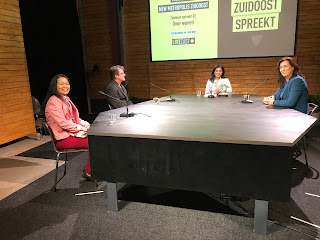Heritage Education in Indonesia
 Between 1-5 November 2008 the Indonesia Heritage Trust (BPPI) and the Netherlands Institute for Heritage (Erfgoed Nederland - EN) organised a training of heritage education for 12 elementary schools around Yogyakarta, Central Java, Indonesia.
Between 1-5 November 2008 the Indonesia Heritage Trust (BPPI) and the Netherlands Institute for Heritage (Erfgoed Nederland - EN) organised a training of heritage education for 12 elementary schools around Yogyakarta, Central Java, Indonesia.In 2006 I drafted the idea to introduce heritage education in Indonesia. I have brought the proposal to Elisabeth Wiessner as my "date" of Stepping Stones program. She works for EN and has experiences about heritage education in the Netherlands. We worked out the proposal together, back and forward finalising it and looking for possibility of funding. It took almost a year when finally EN decided to fund the project itself.
January 2008 we started the project and supposed to end it at September 2009. This is a pilot project to find out a method and materials for heritage education in Indonesia with a trial location in Yogyakarta and surroundings. We showed the materials from the Netherlands and also shared the experiences in the hope that can accelerate the process and avoid the same mistakes if there is any. Cees Hageman joined the force and also a big group from Yogyakarta. In May 2008 the EN and BPPI team met in Jakarta and signed an MoU in the Royal Netherlands Embassy.
The Training in Prambanan area this November attended by teachers and headmasters from 12 elementary schools. For five days we introduced what heritage education is and how to introduce it to the students as an insert to the current curriculum. The BPPI team has worked hard to define the best way to conduct the introductions, not only in the conference room of Hotel Galuh but also visiting sites. The site visits were once under the heat of the sun and the next day was constantly under the heavy rain. Despite of the harsh weather, the participants were enthusiast and kept moving from one program to another program. We started mostly at 8am and back to our bed at about 11pm. Long days.
I enjoyed and learned a lot from my interactions with the participants and the resource persons. The participants are the elementary school teachers who never heard even the word 'heritage.' Sometimes their comments or opinions could be surprising and also refreshing, a kind of reminding for me and other heritage freaks that not everyone out there knows what heritage is. When we had a site visit to Sogan Village, Pak Tukiman talked to me, "Why is this village a heritage? I live in this kind of village, too. When we played the music using the rice sticks from wood, I have that, too, at home. When we saw how the soybean cake -tempe- was made, nothing is new for me because I eat tempe very often
 . For me, what interesting is to see city or computer with high technology. " The heritage freaks from city thought that Sogan Village is an interesting example of cultural heritage, but Pak Tukiman didn't understand why it is cultural heritage. For him, a tour should be a place where he could see something new and unusual. The awareness of heritage is too abstract to define and also depend on who's point of view. That kind of comment was refreshing for me. It was honest and made me realised that who we are to say that this or that is a heritage.
. For me, what interesting is to see city or computer with high technology. " The heritage freaks from city thought that Sogan Village is an interesting example of cultural heritage, but Pak Tukiman didn't understand why it is cultural heritage. For him, a tour should be a place where he could see something new and unusual. The awareness of heritage is too abstract to define and also depend on who's point of view. That kind of comment was refreshing for me. It was honest and made me realised that who we are to say that this or that is a heritage.From the plenary sessions, I got an idea from all presentations that the participants understand heritage as a form of traditional cultural creations such as batik, wayang (puppet), old recipes, etc. It is promising that everyone agree on taking the Javanse language as a communication means at school on certain days. I have to admit that heritage has a very broad definition and scope. It is possible to classify almost all aspects of life as heritage as long as they contribute to identity formation of a community. But the most important is not finding the best definition but catching the essence of it and live with it day by day.
It was rejuvenating to be back to the heritage habitat, even better because it represented both Indonesia and the Netherlands. We are all struggling to the same destination : a future generation with a better understanding about their heritage.



Comments